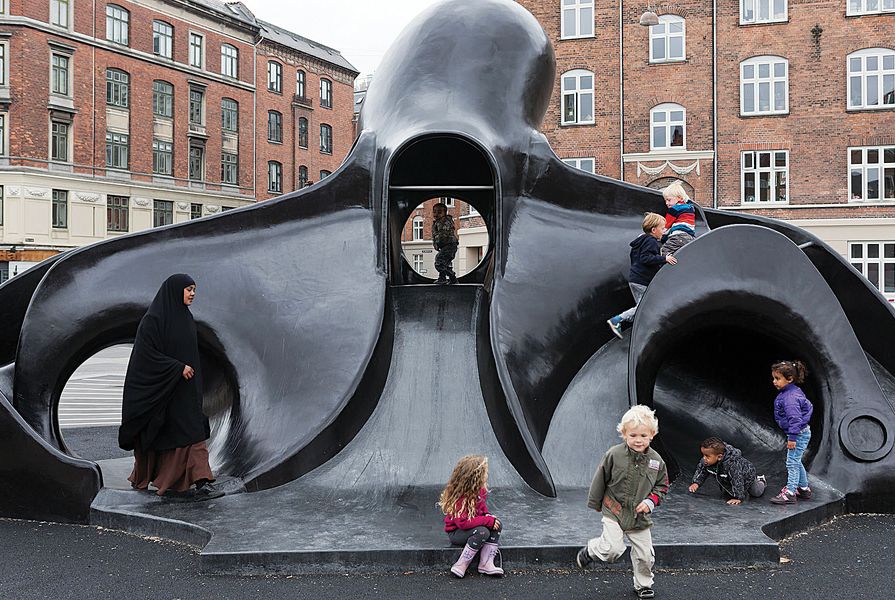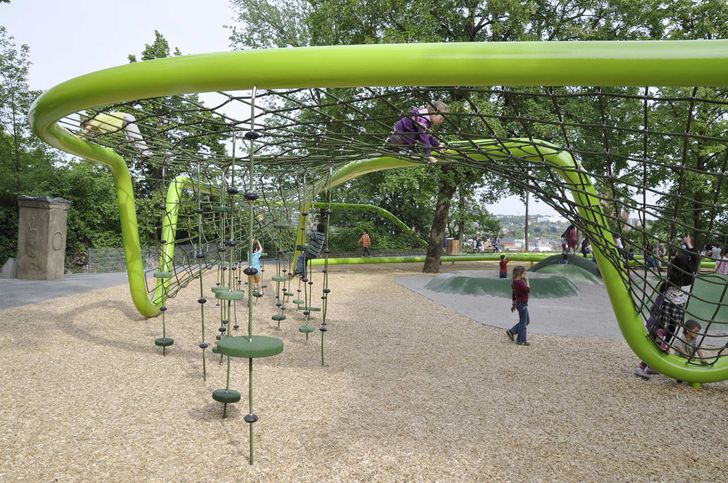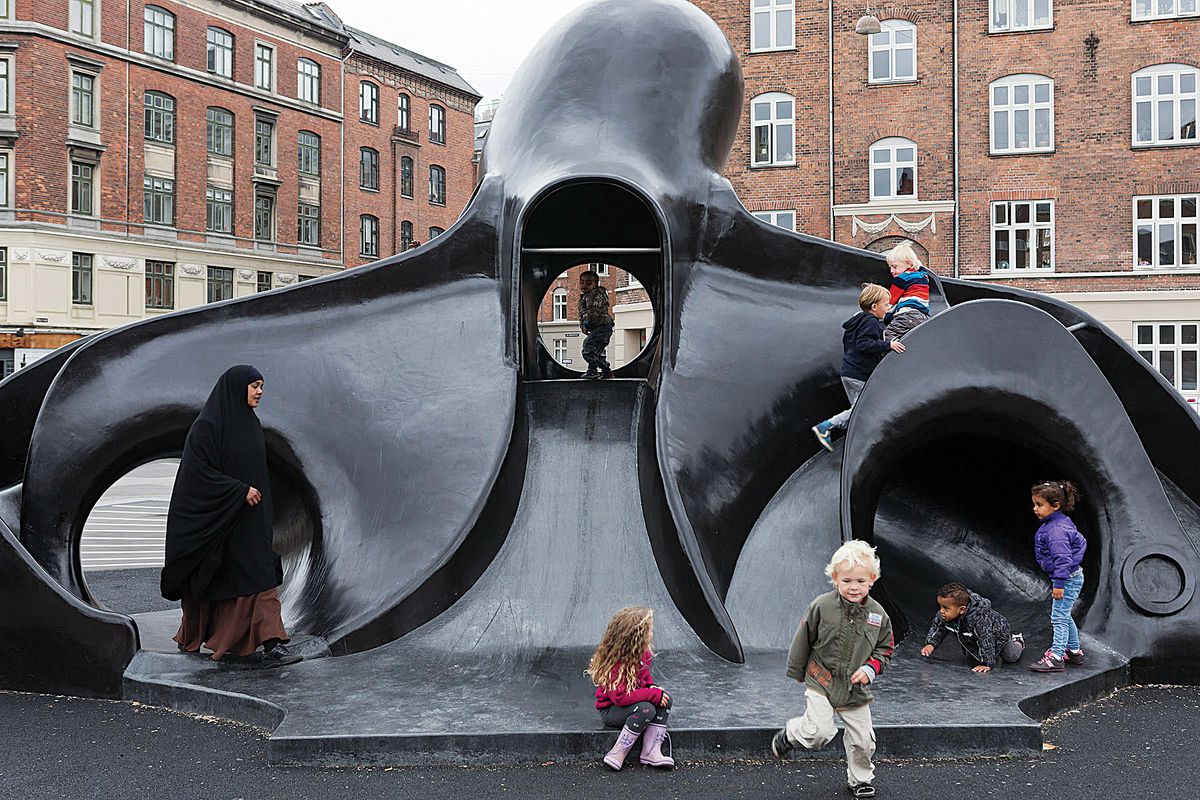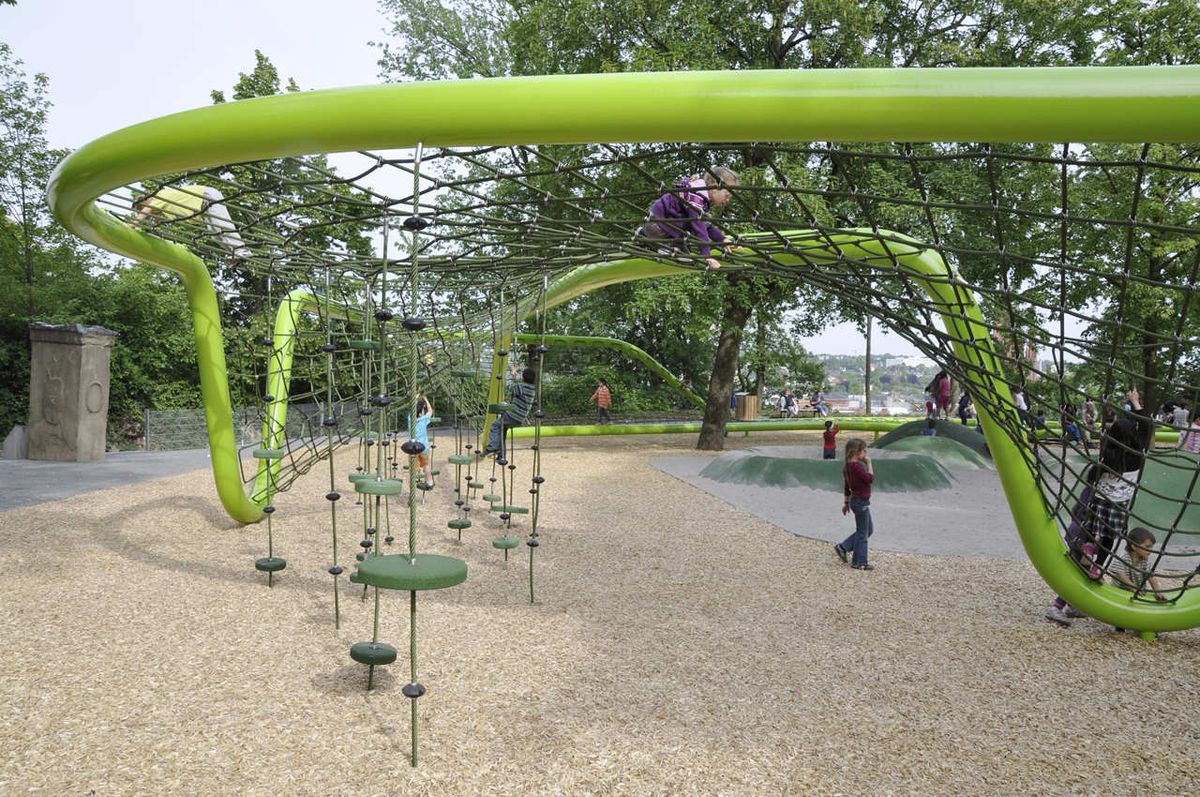It is hard to tie down an exact name, or even a distinguishing feature, of contemporary design. It has been suggested that landscape architecture is in a phase of ‘sustainable postmodernism,’1 but whatever we call it, I think it is fair to suggest that designers of public spaces have come to appreciate clean lines, order and comprehensibility. Upon those bones, there are layers of narrative, green principles and social ergonomics which tissue-paper over the structure, but we feel that for a space to be great, it must be pleasingly organized.
This is all very well for adults. Time poor and overloaded with information, we need a space we can ‘scan’ and understand easily. As Alain de Botton suggests, “We require consistency in our buildings, for we are ourselves frequently close to disorientation and frenzy. We need the discipline offered by similarity, as children need regular bedtimes and familiar, bland foods. We require that our environments act as guardians of a calmness and direction on which we have a precarious hold.”2 I’d like to look at whether this model of public space design works for children, any more than bland foods really do.
At the heart of this is a concern that by designing places that impose adult ideals and aesthetics over those of our children, whether consciously or otherwise, we send messages about their importance to us. To put it another way, “Landscape design conveys the values of a community and ultimately impacts whether individuals are welcomed or excluded from a space. Designed spaces can profoundly affect individuals, communities, and society at large.”3
Generally, it has been assumed that children value formal order less than adults – but is this true? Children do seem to benefit from the stability of a predictable routine. Structuring of time appears to give children a confidence and security that allows them to explore the world at their own pace.4 However, I think it is worth distinguishing between the ‘routine’ of time, and the ‘regularity’ of space. Any visitor to a typical early childhood centre at the end of the day will find what appears to be a messy space, with materials, toys and other apparent junk strewn about. However, to the child’s eye, this is often a rich environment with a density of things to do and explore.
I think there may be two things at play here: scale and description. Do you remember a place from your childhood, which when revisited, was so much smaller than you recall? For me, the steps in my grandfather’s house were quite a challenge – they had open, slippery timber treads and it felt like bridging a chasm to step from one to another. Coming back to the same house as an adult, they are nothing out of the ordinary. How then must a large paved plaza space at a town centre seem to a child?
The other difference in perception is in how we see the world from a functional perspective. To quote Maria Kylin:
Children, especially in urban areas, live and act in environments planned and monitored by adults. Adults, planners not excepted, describe and plan these environments through an adult and professional perspective using cognitive and physical classifications. However, children mostly describe the same environment in terms of activity and meaning.5
That is, adults create abstract justifications and satisfactions to a place: whereas children are more grounded in the significance of a place, and what they can do there. It is becoming widely recognized that children learn by doing, not just by observing,6 and adult learning is also more effective in this mode.
To be able to appreciate a space for its abstract qualities, there is a clear developmental stage that we all need to go through, starting with the sorting of objects into different categories, usually in the preschool years. The ability to generalize about an object’s characteristics (for example, these are all blue, even though they may be all shades from sky to navy), is the precursor to mathematical principles and may be the seed of an appreciation of the platonic forms (cones, spheres and other ‘perfect’ forms), which underpins much modern design. As Le Corbusier said:
These things are beautiful because in the middle of the apparent incoherence of nature or the cities of men, they are places of geometry, a realm where practical mathematics reigns… And is not geometry pure joy?7
Children however need the opportunity to explore and investigate things, rather than just look at them. By creating places where the range of allowed activities is prescribed we may limit their ability to learn about the world, although children are very skilled at subversion. If children need surprise and challenge to learn, then an ordered and predictable space presumably offers decreased opportunity for this to occur.
Arguably, adults (perhaps particularly those who manage the risks associated with public open space) have a deep seated sense of caution about allowing this to happen. Mess makes us uncomfortable – wary even. As documented in other sections of this book, a creeping malaise of risk aversion has inclined us to design spaces that seem safer, but are also more open to inappropriate use and are perhaps duller for everyone.
As far back as 1972, Simon Nicholson identified this dilemma in his Theory of Loose Parts, which states, “In any environment, both the degree of inventiveness and creativity, and the possibility of discovery, are directly proportional to the number and kind of variables in it.” He suggests that our society allows the designers, architects and builders to have all the fun, leaving everyone else feeling as if they are too incompetent to create something – but also identifies how much people would love to interact with the world, given the opportunity.
In 1970, the Institute of Contemporary Art in London held an interactive exhibition Play Orbit, which was soon followed by work ‘parts’ by artist Robert Morris at the Tate Gallery. A contemporary critic noted, “the public got into the party spirit – a somewhat overzealous participation. They were jumping and screaming, swinging the weights around wildly – the middle-aged in particular. The children were the most sensible of all the visitors.”
Research suggests that more creative children are those who are given choices about their environment, and creative problem solving is also enhanced by physical environments designed to stimulate the senses. It might be supposed that chaos is then inherently connected to creativity, but this is not necessarily the case. As children develop, a more systematic and structured method of problem solving has been observed to occur. Having a structure and framework allows an idea to be maintained, tested and creative approaches developed, much in the way that an artist working through a particular phase in their career would. Perhaps the most famous example of this, Picasso, went through many different phases of his career – blue, rose, cubist, neo-classicist, surrealist and so on – and could very well be described as playing with each of these within a distinct structure.
So, given that our understanding of what children really require in a space is limited, and by imposing planned spaces we also may be restraining to their creative potential, is designing children’s spaces counterproductive?
There are certainly some who would say so. Proponents of true adventure playgrounds, which are usually defined places in which children can build with real materials, often speak about the real delight children take in constructing their own environments.
Sculptural playground, Schulberg, designed by ANNABAU Architektur und Landschaft.
Image: Courtesy of ANNABAU
Erin Davis, who made a film about The Land adventure playground in Wales, suggests “It’s really more about child-directed play than ‘risky’ play, per se. When a child chooses the content and direction of an activity, it’s likely that eventually something about it will make adults cringe. Committing to support child-directed play means relinquishing control and managing your own feelings of discomfort. At its core this is an act of deep respect for the child and their experience … So ultimately I think it’s about control and power. People who have power over others – in this case, adults over children – are often reluctant to share it.”8
Likewise, studies into cubby or den building suggest that adults are not always welcome in these activities. Given the opportunity, children will carefully select an area of vegetation that has a degree of concealment, but also with space defining qualities that allow them to observe the world in privacy. One of the main reasons given for abandoning a favourite haunt was that it was no longer secret.9
Although it may be possible to consider giving over some land and control to children, ultimately our public environments are ones we must share. I would suggest two strategies to improve them for us all.
The first of these is embedding complexity. By this, I do not mean chaos, fuss or frivolous levels of ornament for its own sake. It is possible to create rich and interesting spaces that are still easy to interpret and navigate. Building in delight, surprise and change takes a playful attitude to design and may be assisted through the clever use of materials, inclusion of artwork, consideration of scale and careful choice of seasonal planting. People are, after all, highly complex and varied – why then should we think that we will all find pleasure in an expanse of grey concrete? William H Whyte once said, “It is difficult to design a space that will not attract people. What is remarkable is how often this has been accomplished.”
Simplicity in design is surely one of the most difficult of all aspects to achieve, although this may come as a surprise to many outside the profession. The temptation to keep playing, to keep solving problems, to keep tinkering without integration into an overriding scheme is sometimes overwhelming, particularly when there are many different stakeholders. However, this does not create complexity, but chaos. As Terence Conran said, “Simplicity, however, should not be confused with simplistic … Simplistic does not rule out precision, craft or finesse.”10
Think for example of a beautifully crafted handmade object – perhaps a Japanese ceramic bowl. There is a richness of patina, of shape, of imperfection, which is brought about quite deliberately and is yet contained within a very simple and clean shape. There is the potential for different layers of interaction with such a piece. I would suggest that by incorporating this level of thought and sensory detail into our public spaces we have a greater chance of making spaces that have interest for children at the smaller scale at which they perceive things, yet with the modernity and legibility adults crave.
The second strategy to improve public space is to wholeheartedly embrace play. As discussed in relation to the notorious Play Orbit exhibition, adults also appreciate the opportunity to be allowed to play. They may not wish to squash down a fibreglass slide, but there are many examples when we are invited to play. On the banks of the Yarra river in Melbourne, a giant musical Theremin was installed for a while, which sang to passersby depending on their movement past it and allowed up to eight users to interact polyphonally.11 The Theremin’s creator Robin Fox noted “The project was a lot of fun and led to some surprising public interactions ranging from Tai Chi groups gathering around it in the mornings to groups of young BMX’ers jumping in sonic loops off the face of the works.”
Likewise, playful spaces – not necessarily playgrounds as such, can enliven our cities and bring communities together while subliminally giving the idea that children and young people are actually welcome in our public spaces. For example, the Sculptural Playground in Schulberg, Germany has been described as “a crafty alternative to the simply green-play lawn or deconstructivist forest type of urban park. The central idea of reclaiming an area in the name of play has given this city centre a fun gathering space. A giggle instead of a hiccup along the medieval streets and town squares.”12
This essay is an excerpt from the recently released book How to Grow a Playspace: Development and Design, edited by Katherine Masiulanis and Elizabeth Cummins, 2017, Routledge, 348 pages. Purchase here.
1. Tom Turner, 2013, British Gardens: History, Philosophy and Design, Oxford, Routledge, Taylor & Francis.
2. Alain de Botton, 2006, The architecture of happiness, Australia, Penguin Books.
3. Diana Witcher. ‘Isamu Noguchi’s Utopian Landscapes’Journal of Student Research, p. 76.
4. Dr. Laura Markham’s website: Aha! Parenting. Accessed December 2014. http://www.ahaparenting.com/parenting-tools/family-life/structure-routines5. Maria Kylin, ‘Children’s dens.’ Children, Youth and Environments Vol 13, No.1 (Spring 2003). http://www.colorado.edu/journals/cye/13_1/Vol13_1Articles/CYE_CurrentIssue_Article_Dens_Kylin.htm. Accessed December 31, 2014.
6. Alison Lee, Childminder’s Guide to Child Development, p. 65.
7. Le Corbusier, 2006, quoted in Alain de Botton, The architecture of happiness, Penguin Books (Australia), 2006
8. ‘Inside a European Adventure Playground’ by Kasia Cieplak-Mayr von Baldegg - The Atlanic http://www.theatlantic.com/education/archive/2014/03/europes-adventure-playgrounds-look-way-more-fun/284521/. Accessed June 30, 2015.
9. Kylin, ‘Children’s dens’ Children, Youth and Environments Vol 13, No.1 (Spring 2003). http://www.colorado.edu/journals/cye/13_1/Vol13_1Articles/CYE_CurrentIssue_Article_Dens_Kylin.htm Access December 31, 2014.
10. Terence Conran, 1996, Terence Conran on Design, London, Conran Octopus.
11. http://robinfox.com.au/projects/giant-theremin/ Accessed June 30, 2015
12. Didactic Discourse Blog’, Sculptural playground, Schulberg, Location : Wiesbaden, Germany. https://didacticdiscourse.wordpress.com/2011/10/27/sculptural-playground/ Accessed May 18, 2015.














